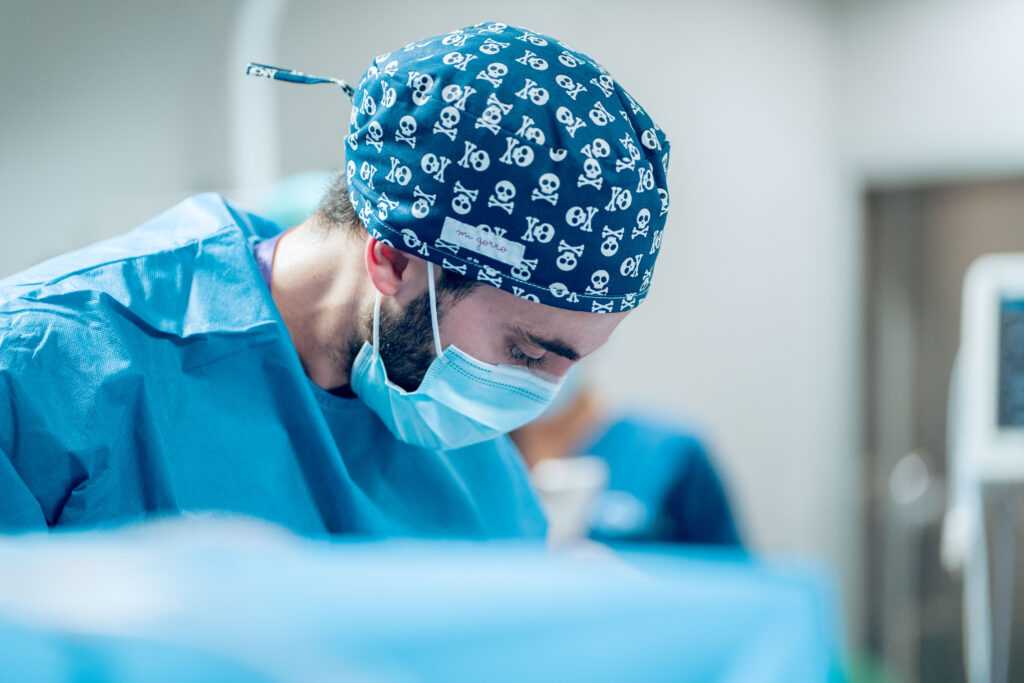Published by Dr MIguel Fernadez Calderón: 08/06/2023
Sudden weight loss and multiple pregnancies can leave skin sagging and flabby. And it is not always possible to correct this problem through dieting or exercise. Surgery then becomes the most viable option, so we explain you what you should know before abdominoplasty.
What is a tummy tuck?
Abdominoplasty or tummy t uck is an intervention with which excess skin and fat is removed from the abdominal area. This improves the appearance of the belly, as the muscles are strengthened and the skin is tightened.
It is a more complex procedure than liposuction and requires making an incision above the pubis. Through this incision the skin is stretched and the excess is cut. Finally, the incision is closed and the navel is repositioned if necessary.
The size of the scar will depend on the amount of tissue to be removed, and ranges from a mini-abdominoplasty to a circumferential abdominoplasty. The latter includes the back area.
Ideal candidates
Before undergoing abdominoplasty, the surgeon must ensure that the patient is an ideal candidate for this type of procedure. To do so, he/she must perform a general check-up on the patient, so as to verify that both the physical and mental health of the person is optimal.
In addition, the patient must have an adequate and stable weight, that is, he/she should not be in a process of weight loss. Fluctuations in size can affect the results.
It must be remembered that abdominoplasty is not a weight loss surgery and that the patient cannot be obese, but must have excess skin and fat to be removed, which is the main objective of this type of tummy tuck surgery.
It is also important that the patient has realistic expectations regarding the results that can be obtained after abdominoplasty and that he/she is aware of how the recovery process will be, and of the risks and complications that the operation may entail.
On the other hand, candidates for abdominoplasty must be committed to maintaining a stable weight after the procedure for the results to be long-lasting.
What should you know before undergoing abdominoplasty?
Abdominoplasty is a popular surgical technique to improve body contouring and is performed on both men and women. Although the main reason for performing it is aesthetics, it is also done for health, as it helps to eliminate excess weight.
In addition, by achieving a better figure, the patient's self-esteem improves and he/she begins to feel more confident with the new proportions of his/her body.
The abdominoplasty procedure can be complex and undergoing it is a personal decision. However, with the right choice of surgeon it is quite safe and the results are satisfactory.
If you are considering this alternative to get a flatter and firmer belly, here is what you should know about this procedure.

What abdominoplasty techniques are available?
There are different types of abdominoplasty that are applied according to the amount of skin and fat to be removed. These are:
- Classic abdominoplasty. It removes excess fat and skin in the central part of the abdomen, between the navel and pubis. A horizontal incision is made from hip to hip.
- Miniabdominoplasty. It is performed when there is a little sagging skin and fat above the pubic area. It can be with or without umbilical disinsertion.
- Circumferential abdominoplasty. It is also known as 360 abdominoplasty, since it also involves the back area.
- Reverse abdominoplasty. It is performed when the excess skin is above the navel.
During the previous consultations, the surgeon will explain the different types of abdominoplasty and will explain which one is the best according to your situation.
How long does the surgery last?
The length of the procedure depends on the type of abdominoplasty to be performed. A mini-abdominoplasty may last two hours, but the surgery may be extended for six hours if the surgery is complete or circumferential.
In addition, it can be combined with other procedures such as liposuction or abdominal diastasis correction, which will add time in the operating room.
After surgery, the patient must remain in the clinic for one to three days.
When is abdominoplasty recommended?
Abdominoplasty surgery is recommended for women who due to one or more pregnancies have excess skin in the abdomen. Likewise, to men and women who have had sudden weight loss which causes the skin to hang in the abdomen.
The goal of abdominoplasty is not to lose weight. In fact, the patient must be close to his or her ideal weight to have the surgery. What is achieved is to give a firmer appearance to the abdomen by removing flabby tissue.
How is the recovery?
Recovery after abdominoplasty takes time. During the first ten days the patient should be resting; however, it should not be absolute, it is recommended to get up and take short walks at home.
At first it is necessary to walk hunched over so as not to strain the scar, after four weeks the correct position can be adopted. At this point, more intense walking is possible.
Recovery may take two months, even longer. During that time you may have bruising and swelling.
For all these reasons, it is advisable to prepare to rest for a while before resuming your normal activities. You will be able to return to work after the third week, if it does not involve activities that require physical exertion.
Best time to have an abdominoplasty performed
First you must be clear that this procedure can be done at any time. You just need to talk to your surgeon to determine the most convenient date for you.
Many people do it during vacation time at work to take advantage of that time off.
On the other hand, there are also those who prefer to do it during the fall or winter for convenience. During these months, recovery is more bearable. For example, loose clothing allows hiding the compression garment, which is necessary after surgery.
Preparation for the surgery
The surgeon will give the patient all the instructions to follow before undergoing abdominoplasty. It is necessary to follow these recommendations so that the intervention and recovery are safe.
Preoperative care includes exams to make sure the patient is healthy; eliminating alcohol and tobacco consumption several weeks in advance, keeping the skin hydrated, and not consuming medications that affect blood coagulation. Likewise, foods that favor fluid retention should be avoided.
Any questions should be discussed with the surgeon prior to surgery.

How much weight is lost after abdominoplasty?
Although abdominoplasty is a surgery to improve body contouring and not for weight control, it is possible to lose a few kilos.
With this surgery it is possible to lose about five kilos by removing excess skin and fat. The total amount of weight lost will depend on the amount of tissue removed.
What is the abdominoplasty scar like?
When a patient undergoes a tummy tuck they should expect a large scar. In the traditional procedure, it is performed from one hip to the other, just above the public area. This way it can be hidden under the underwear.
But the incision may be extended to the sides or even to the back if tissue is to be removed from this area. A vertical incision may also be required.
This means that the size and position of the scar will depend on the type of abdominoplasty performed.
The first few days after surgery, you will lose sensation where the incision was made. This will recover gradually and may take several months to recover in full.
After 15 days the suture should be healed; however, it is important to avoid tension in the area. It is therefore recommended to walk hunched over for three weeks and not to sleep with the body fully extended.
Likewise, the necessary care must be applied to the incision while it is red.
Post-surgical care
For the first two or three days, the patient will remain hospitalized and will be cared for by the healthcare staff. Once you go home, it is necessary to follow the surgeon's instructions to ensure a smooth recovery.
This care includes:
- Maintain the drains for the time indicated by the surgeon and care for them as directed by the surgeon.
- Comply with the rest time recommended by the specialist. Recovery will take at least two months, during which physical exertion should be avoided.
- Sleep on your back with your legs slightly bent or your upper part slightly inclined to avoid tension in the central area.
- The patient should shower daily once the drains are removed. If you have a girdle, use a sponge.
- Take care of the scar, for this you can use reducing adhesives once it has completely closed.
- Avoid smoking, as smoking delays healing.
- Wear the compression garment for the time indicated by the surgeon.
- Do not do strength exercises until at least two months after surgery or as recommended by a physician.
Are the results permanent?
Maintaining the results of abdominoplasty will depend on the patient. That is why you must be committed to a healthy lifestyle and avoid weight fluctuations.
If you gain weight, the skin will stretch again and if you lose more than five kilos after the operation, you will notice the excess skin again.
Are there non-surgical alternatives?
The results that can be obtained from a tummy tuck cannot be compared to other non-surgical procedures, since this surgery achieves impressive results. However, procedures such as cryolipolysis, which freezes the fat and then eliminates it naturally, offer optimal results and improvements in the overall appearance of the body.
Radiofrequency and ultrasound can also help to achieve a firmer abdomen and a more defined figure.
Benefits and risks of abdominoplasty
Understanding the advantages and possible complications of a tummy tuck allows the patient to make an informed and conscious decision.
Aesthetic and functional advantages
Thanks to an abdominoplasty can be obtained improvements in the appearance of the abdomen, making it look flatter and firmer. It also helps reduce stretch marks in the abdominal area and improves the silhouette, offering a slimmer figure and a smaller waist. This in turn brings as a benefit that the patient feels more comfortable with the way their body looks and increases their confidence and self-esteem.
In terms of functional improvements, an abdominoplasty strengthens the abdominal wall and can correct hernias, as well as improve body posture. Also in some cases it can improve or solve urinary incontinence.
Potential complications
Abdominoplasty is an invasive surgery, so it carries certain risks and complications that are important to be aware of before undergoing the procedure.
- Infections in the incisions or treated area.
- Unfavorable reactions to anesthesia.
- Possible bleeding during surgery or in the postoperative stage.
- Scarring problems or appearance of seromas.
- Pain, numbness and tingling caused by nerve damage during surgery.
Every patient is different and your body may react differently to surgery; however, many of these risks can be reduced by choosing a skilled professional who performs a proper pre-operative check-up and whose expertise can provide a successful outcome.
Risks of abdominoplasty
As in any surgery there is a risk of hematomas, seromas, inflammation and infections after abdominoplasty. As well as those related to anesthesia.
To avoid complications, the surgeon must ensure that the patient is in good health. And the patient must comply with all medical indications.

Choose a certified plastic surgeon
If you are going to undergo this surgery, choose the best abdominoplasty surgeon in Madrid Spain. This way you will be sure that you will have a good result and the risks of complications are reduced.
Confirm the surgeon's credentials before undergoing surgery. Also make sure he/she is experienced in abdominoplasty and ask to see photographs of previous procedures.
A good surgeon will answer all your questions with clear arguments and will not hesitate to talk about his background and show you previous work. He will also recommend the best technique and be honest about what is best for you, making sure you have realistic expectations.
This information summarizes what you should know before undergoing abdominoplasty. It is important that you clarify all your doubts to know if this is the right surgery for you.









